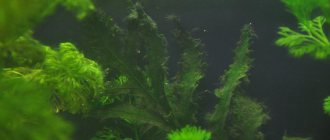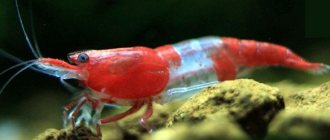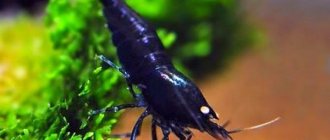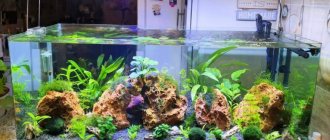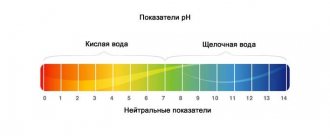Phosphates are salts of phosphoric acids that are inorganic in nature. The source of phosphates is organic pollution in the form of food residues, dead aquarium plants or fish waste. But why are phosphates needed? aquarium and what can their deficiency lead to? This will be discussed in more detail in this article.
Phosphates in the aquarium
What do they influence?
This is an important biogenic element that affects all life processes that occur in the aquarium. Therefore, excessive amounts of phosphates can provoke an uncontrolled increase in algae . As a result, the aquarium may become saturated with nutrients, or scientifically called eutrophication. In turn, this can cause a once clean and well-kept aquarium to naturally turn into a less attractive swamp .
Determination of phosphate concentration
Some of the algae can produce toxins that have a detrimental effect on the fish's body. We are talking about blue-green algae (cyanobacteria) that can cause Haffa disease in fish. The infected fish loses a lot of weight, has trouble breathing, and eventually dies. Therefore, it is important to control the concentration of the chemical element in water at the proper level.
Why 16/1 is 10/1
The ratio of Nitrogen to Phosphorus is called the Redfield ratio. But if we take the fertilizer mono-phosphate solution and mono-nitrate solution, and then make some kind of ratio between them, then we will get the Buddy ratio, not the Redfield ratio.
- In aquariums we use tests to measure Nitrates and Phosphates. In many articles you may have seen a ratio of 10:1 or 16:1, but this is a Redfield ratio (Nitrogen to Phosphorus).
- In order for our Nitrate and Phosphate test values to be brought correctly to this ratio, the measured NO3/PO4 value must be multiplied by 1.54. This will be the Redfield ratio.
Example:
In the measured water, Nitrates 15 mg/l, Phosphates 1 mg/l: Redfield ratio: (15:1)*1.54=23, not 15.
Therefore, it is very important to understand what values you are operating with. Nitrate/Phosphate or Nitrogen/Phosphorus.
It can vary from 7:1 to 25:1.
It depends on your particular aquarium. Each aquarium has its own optimal ratio of Nitrogen to Phosphorus. That is why a universal fertilizer cannot exist purely physically. But! In complex fertilizers, the average value of nitrates/phosphates (16:1) is selected and it is likely that it will suit you.
And further.
The greater the diversity of biomass in the aquarium, the more different types of plants, the higher the likelihood that a complex fertilizer will be suitable for your aquarium.
Why?
This is due to the fact that different plant species require different ratios of nitrates and phosphates. Some 8/1, some 25/1. Let me give you an example of an Iwagumi-style aquarium with glossostigma. This aquarium was in my care for about a year.
By increasing nitrate and potassium, without changing the amount of phosphates and trace elements supplied, I saw an instant reaction: the glossostigma immediately began to stretch, increasing the size of the leaf. The height of the stems reached 20 cm. At the same time, the concentration of nitrates did not increase due to its active consumption.
So, glossostigma eats a lot of nitrates and very little phosphates. Based on this, using a standard complex fertilizer, you can get a shortage of nitrates, and then completely eliminate it. After some time, the appearance of cyanobacteria (blue-green algae) in such an aquarium is inevitable.
In such aquariums, complex fertilizer can be combined with a mono-nitrate solution.
A logical question may arise: is it possible to simply increase the supply of complex fertilizer to such an aquarium in order to level out the lack of nitrates? No you can not.
Because it is nitrate that will continue to be actively consumed, and the remaining elements of the complex fertilizer will begin to accumulate. This is fraught with the emergence of various types of algae, including green (filamentous), red (blackbeard).
I consider complex fertilizers:
Tropica Special Nutrition
Aquabalance Total
I recommend using such fertilizers in aquariums with a varied plant biomass (the number of species is 5 or more) and with a nitrate content of no more than 5 mg/l by the end of the week.
Recommended value
If there are no plants , and only fish live, then the indicators of phosphoric acid salts should approach zero. But in the case of a full-fledged aquarium populated with flora and fauna, the amount of phosphates should be proportional to the amount of nitrates . Moreover, this value depends on several factors and may be different in each individual case.
To determine the amount of phosphates, special tests are used
Note! The generally accepted ratio of phosphates and nitrates is 1:10-15. You need to start from this value.
Statement on permissible concentrations of compounds in water
Below is a list of acceptable and hazardous amounts for the compounds described above.
| Name | Recommended amount [mg/liter] | Dangerous amount [mg/liter] |
| Carbon dioxide CO 2 | 10-15 | more than 50 |
| Oxygen 0 2 | 5 | less than 2 |
| NH 3 Ammonia | 0 | above 1 |
| Nitrate NO3 | 5-10 | more than 50 |
| NO 2 nitrites | 0 | above 0.2 |
| PO 4 phosphates | 0,5 | above 3-4 |
| iron | 0,1 | above 1.5-2 |
Where do they come from
Despite the importance of this macronutrient (it is needed for photosynthesis and the development of cell membranes of underwater plants), excess phosphate has a negative effect on aquarium inhabitants. But if we talk about artificial aquariums, the appearance of phosphates in them is not always associated with the chemical composition of the water.
Excess phosphate has a negative effect on aquarium inhabitants
The following can act as a source of phosphates in artificial reservoirs:
- waste products of aquatic organisms ;
- small particles of feed;
- dead parts of aquarium plants;
- rainwater (it may contain salts);
- tap water, which often has phosphates added to protect pipes.
Important! Provided that the nitrogen concentration in the aquarium is low enough, phosphates can appear from the very ecosystems. Other factors can also provoke an increase in the concentration of a chemical element, for example, prolonged illumination of the aquarium.
TOP 11 unpretentious aquarium fish TOP 10 largest aquarium fish TOP 20 beautiful aquarium fish TOP 12 most expensive aquarium fish
Video - Where do phosphates come from in an aquarium?
Dosage
Depends on the starting conditions in the aquarium:
I recommend adding microelements and potassium to such an aquarium. We'll talk about them later.
- If in your aquarium the nitrate value is, say, 5 mg/l and phosphates are outside the detection zone (to a lesser extent) by the end of the week, then you can add complex fertilizer to such an aquarium to avoid zeroing out nitrates and phosphates.
- The dosage depends on the hardness of the water. The softer the water, the easier the elements are absorbed. Thus, if your water is 0-4 gH and kN in the same range, apply half the standard dosage. If water with a total hardness gH above 8, you will most likely need to apply fertilizer 1.5 times the standard dosage.
But it is better to start with a standard dosage and carefully monitor the behavior of the plants and the readings of nitrates and phosphates. They shouldn't start to accumulate.
Let's say you have 5 mg/l nitrates and 0.5 mg/l phosphates in your aquarium. The measurement was taken on the 3rd day after the water change (assuming you do water changes once a week).
- You cannot pour complex fertilizer into such an aquarium, due to the fact that nitrates and phosphates are already present in your aquarium and they accumulate, so why add them additionally? I recommend adding only potassium and trace elements to such an aquarium.
- If the volume of your aquarium does not allow you to apply 1/2 of the standard dosage of complex fertilizer daily, for example, you have 15 liters of water, and the dosage is 1 ml per 60 liters of water, then apply the fertilizer every other day.
Thus, complex fertilizers containing nitrates, phosphates, potassium, iron and microelements, although they seem universal at first glance, are not applicable in all aquariums.
Level determination
To determine the level of phosphates in aquarium water, many aquarists use NILPA PO4 Test Phosphate. This is a special indicator, which includes small bottles with reagents, a measuring cup, a color scale for determining the concentration of a substance and instructions from the manufacturer . You need to act only after reading the instructions.
The color scale will help in determining the concentration of a substance
The sequence for measuring phosphate concentration levels is as follows:
- The reagents in the bottles must be shaken thoroughly;
- rinse the glass with aquarium water, preferably twice;
- pour a few drops of water from the aquarium into a measuring container;
- from container No. 1 you need to add a few drops to a glass and mix;
- add two drops from the second bottle to a glass of aquarium water, mixing the components again;
- place the container next to the color scale after the reaction is completed and, after waiting a few minutes, compare the resulting shade. The bottle should be placed on a white background to determine the color more accurately;
- Upon completion of the procedure, the container must be washed with running water.
On a note! The resulting solution should be kept near the measurement scale for no more than 6-7 minutes, because then the control color may change.
Depending on the color saturation of the liquid, you can determine the concentration of phosphates in aquarium water. If the resulting solution is colored rather weakly, this indicates a low level of the chemical element. But it is worth noting that the absence of shades in the tested water may also indicate the presence of traces of phosphorus.
How to determine the concentration of phosphates in aquarium water
It is recommended to repeat the procedure for determining the phosphate level during each water change . Only a quick and timely reaction when high phosphate levels are detected will prevent undesirable consequences for fish. Also, when measuring, it is important to take into account the individual parameters of aquarium water, because it was previously mentioned that the norm can fluctuate and depend on the characteristics of the aquarium and its inhabitants.
Water parameters and ways to change them
2.1. Water pH and control
Chemical compounds dissolved in water affect its pH, measured by the pH factor. In most cases, suitable water has a neutral pH, i.e. pH = 7. The pH of water can be measured very accurately using a pH meter (however, this is an expensive device to purchase), less accurately using color indicators in the form of solutions (for example, bromothymol blue - pH range 6.2-7.6, methyl red - range). pH 4.2-6.3, however, are not very practical methods), available in zoological stores with histograms (their advantage is that in addition to pH they also indicate other water parameters, for example: carbon dioxide level, water hardness, nitrites, nitrates and others) or with pH (cellulose, litmus or other dye impregnated). In practice, we are more likely to make tap water acidic (necessary for the reproduction of certain species) than to make it alkaline. A decrease in the pH of water can be achieved by passing it through a filter filled with peat or alder (when reducing the pH to 6-6.5, remember that the filtered water must first be softened). Of course, pet stores also have ready-made acidifying agents. To increase the pH of the water, you can use ready-made preparations available in aquarium stores or sodium carbonate. To lower the pH, the water can be mixed with distilled water or a reverse osmosis filter that separates the salts from the water, producing soft water. To increase the pH of the water, you can use ready-made preparations available in aquarium stores or sodium carbonate. To lower the pH, the water can be mixed with distilled water or a reverse osmosis filter that separates the salts from the water, producing soft water. To increase the pH of the water, you can use ready-made preparations available in aquarium stores or sodium carbonate. To lower the pH, the water can be mixed with distilled water or a reverse osmosis filter that separates the salts from the water, producing soft water.
You can also use dried black alder cones, from which we prepare a decoction (pour boiling water over it and keep covered until it cools) or use it as an input to an internal or external filter. It is difficult to determine the correct amount, so you must keep a close eye on the pH value. On average, 8-13 cones are used per 100 liters of aquarium water.
We never change water parameters if there are fish in it. It is also important not to overdo it, meaning it is better to change the pH too little than too much. Sudden changes in water parameters at this pH can harm the inhabitants of the aquarium, so we do them in stages.
2.2. Water hardness KH and GH
As is known, carbonate hardness (transitional) KH is removed by boiling water. Other in water, among others Calcium and magnesium sulfates (elusive hardness) can be removed using appropriate ion exchangers. The sum of both hardnesses is called the total hardness GH, which is expressed in German degrees (1 degree corresponds to 10 mg of calcium oxide CaO or magnesium oxide MgO contained in 1 liter of water).
| Descriptive scale for water | Total hardness GH [ºniem.] |
| Very soft | 0-5 |
| soft | 5-10 |
| Medium hard | 10-20 |
| hard | 20-30 |
| Very hard | above 30 |
Ion exchangers (ion exchangers) remove salts (cations and anions) from water. In the aquarium hobby, cation exchangers are used (a porous material or gel has acidic properties, which, when activated, take on a negative charge and are able to bind cations, in our case calcium and magnesium). Each heat exchanger has a certain ionic capacity (the number of ions absorbed on its surface), and after depletion it must be regenerated (cation exchangers are regenerated with a solution of sodium chloride - NaCl). Exchangers work effectively with slow water flow and should always be under water. Pet stores also stock ready-made water softening chemicals. Water hardness can be determined by laboratory methods (gravity method, Clark soap method, titration methods) and testers available in petrochemical stores.
Correction of phosphate levels
Due to the fact that the reasons for the accumulation of phosphates in the aquarium directly depend on the number of plants and fish, the salt level can be adjusted in different ways. Let's look at the most effective of them.
Aquarium care
- Relocation of fish. If you remove a small percentage of fish from the aquarium, then after some time the biosystem will be able to recover. Of course, a second aquarium is needed for relocation.
- Changing your diet. In specialized stores you can buy special granules, which should replace the usual flakes or chips for fish.
- Strengthening fish control. It is important to constantly monitor the behavior of aquarium inhabitants, as well as whether they eat food. If there is still food left, you need to reduce the portions a little.
- Cleaning the filter. It is no secret that over time, food particles can be sucked into the filter , which will then rot. During the decay process, phosphates will be released.
- Soil cleaning. For the same reason as cleaning the filter, you need to periodically clean the soil .
- Water change. It is necessary to periodically change the water in the aquarium (no more than 30%). It is important to monitor the quality of the added water.
Water measurements should be carried out regularly - every time it is replaced.
Note! The filter may not be suitable for a particular aquarium in terms of power and efficiency. Therefore, it should be checked as a preventive measure.
Selection of fertilizers for your aquarium
I described above that there are complex fertilizers that contain both micro and macro at the same time. And that for some aquariums this is a complete solution.
But based on the fact that the consumption of elements in aquariums is different, that there are aquariums with fast-growing plants and with CO2 supply, manufacturing companies began to increasingly produce fertilizers with monosolutions: separately phosphates, separately nitrates, separately potassium, iron and microelements.
- This is very convenient from the point of view of control of the aquarium, but the dosage of each element remains on the conscience of the aquarist.
- So, you will have to independently determine whether to add phosphates (in complex fertilizers they always come together with nitrates and potassium in the correct ratio), if so, then in what proportion with the other elements.
As you saw earlier, the selection of fertilizer dosage depends on many factors, so let’s divide aquariums into types and try to select fertilizers for each of them.
An aquarium with a sufficient number of fish, as shown by tests for nitrate >5 mg/l, with lighting of 0.5 W/l. I’ll call this standard lighting for any store aquarium. Yes, the height of the aquarium also plays a role here. The level of illumination at the bottom in an aquarium with a height of 40cm and 60cm varies significantly.
- Therefore, let's put 0.5 W per liter with an aquarium height of no more than 50 cm. No carbon dioxide supply. There are few plants, they feel good, the aquarium is decorated without Soil. In such an aquarium, I recommend dosing Potassium, Microelements and Iron separately, if it is not included in the microelements.
- Microelements that contain iron are dosed according to iron, so that its concentration does not exceed 0.5 mg/l. Iron has a fairly low toxicity threshold compared to other elements, so it is easy to get negative effects from an overdose. One possible sign of this is filamentous algae.
If iron is added separately, then the dosage is the same - when added it should not be more than 0.5 mg/l. If signs of iron deficiency are detected, the dosage can be increased.
The maximum concentration of iron in water (not when added, but in the aquarium over a long distance) is 1 mg/l. This is the very maximum, which in no case should be exceeded.
Looking ahead, with the lighting indicated above, there is no point in dosing iron with more than 0.2 mg/l (in the aquarium, not when adding it) because the rate of nutrient consumption is low. In the described aquarium, it is also caused by the lack of carbon dioxide supply.
- The dosage of microelements, which do not contain iron, is based on the condition of the plants and the growth of algae. Plaque on glass, black beard, filamentous algae can cause an overdose of microelements.
- The initial dosage for soft water, with readings gH and kN respectively < 4 - 1/2 of the dosage specified by the manufacturer. If you use more hard water: standard dosage.
I recommend dosing potassium even if there are no signs of potassium deficiency in the form of small holes or translucent leaves. The dosage is such that the value matches the amount of nitrates in the water, based on the fact that their consumption is approximately 1:1.
There is no need to add phosphates to such an aquarium, because nutrient intake, as previously stated, is low. But! The aquarium in question does not have nutrient soil in the form of Soil. What helps us here is that we can measure the amount of phosphates in the water.
In aquariums with Soil soils, this is very problematic due to the high sorption (absorption) properties of the soil.
If water tests show us that the water contains 5 mg/l of nitrates and, say, 0.1 mg per liter of phosphates, then we can gradually raise the level of phosphates to 0.5 mg/l (but only if necessary - with visible signs of deficiency phosphates!)
True, there is a nuance here too. Phosphate is a limiting factor for plant growth.
Those. If phosphates are at absolute zero, then plant growth is impossible. Therefore, phosphates should never be 0 mg/l (this only applies to aquariums without Soil).
In this aquarium, the level of nitrates, let’s say, is 5 mg/l, phosphates at the level of 0.1 mg/l, with the addition of Potassium, the concentration of both phosphates and nitrates can change at the same time - both of these parameters can decrease. This is important because influences whether we will still dose phosphates and nitrates into this aquarium in the future or not.
So, we started with the fact that here we will dose microelements, potassium and iron, if it is not included in the microelements. Then we monitor the condition of the aquarium and measure nitrates and phosphates in tests. If they begin to decrease, then we begin to add them until they reach a nitrate level of about 5 mg/l, and a phosphate level of at least 0.1 mg/l.
How much phosphates should there be in water? As we already understood, phosphates definitely should not be at the level of 0 mg/l. Is it possible to make 1 mg/l or 5, for example? After all, this is how we get a constant presence of phosphates in the water and the plants will always have food?
- It would seem yes, but the constant presence of phosphates in the water at a level of 0.5 and above can lead to (this formulation is due to the fact that this is not always true - there are aquariums with a high content of phosphates and there are no algae in them and plants grow well) to stagnation of plant growth, to the accumulation of nitrates and, as a consequence, rapid growth of algae. This situation is especially true for aquariums without carbon dioxide supply.
- But the logic of constantly having nutrients in the aquarium is somewhat correct. Only with an addition. Phosphates should be at a level of approximately 0.1 mg/l, nitrates should be in a Redfield ratio of 10:1 to 25:1 - depending on the needs of a particular aquarium, and this can also be determined by algae, if any are present in the water.
Blue-green algae indicates that the Nitrate content is too low for a given phosphate level. Green algae indicates too high a Nitrate content for a given phosphate level.
If, when adding Potassium and Microelements, nitrates and phosphates remained at the same level, then there is no need to add them additionally.
Very often, aquarists experience overpopulation of the aquarium, due to which Nitrates and Phosphates accumulate. In such aquariums, I would recommend dosing only Potassium, based on the applied dosage equal to the nitrates present in the water: if there are 30 mg/l of nitrates in the water, then the same amount of Potassium should be added.
Next, monitor nitrates and phosphates. When they are reduced to adequate values of 5 and 0.5, respectively, you can begin dosing microelements. Next comes the diagram described above.
Now let’s look at options for adding fertilizers to aquariums with Soil nutrient soil, powerful lighting (more than 1W/l), carbon dioxide supply - with all those mandatory conditions for creating a beautiful aquascape.
The main differences between this aquarium and the one described above:
- fast and large intake of nutrients;
- Soil absorbs phosphates from water and reduces water hardness;
Using Soil soils, tests can measure the amount of phosphates in water only when their accumulation in the soil is no longer possible, due to the fact that the soil has a certain saturation limit with phosphates.
And when it is reached, then phosphates begin to be determined in the water. Therefore, in aquariums where Soil is used, phosphate should not be detected within 4 hours of applying fertilizers containing phosphorus.
If phosphorus fertilizers are not added to the aquarium, then the lack of phosphates can only be determined by the growth (or rather, the lack thereof) of plants.
With a lack of phosphates, plants do not grow or grow, but very slowly, and can become completely yellow (just like autumn grass). Those. It is necessary to dose them in aquariums with Soil (if necessary at all) very carefully and focusing only on the condition of the aquarium.
Another indicator of phosphate deficiency can be GDA algae (green dots on plants and aquarium glass).
How then can you follow the Redfield/Buddy ratio without knowing how much phosphate is currently in the aquarium?
- If there is no phosphate deficiency in the aquarium, do not add phosphates.
- If phosphate deficiency is detected, apply fertilizer with the correct Nitrate/Phosphate ratio, such as 16:1. This is the optimal ratio.
- Observe the growth of algae, if any. Green algae indicates an excess of nitrates, which means the ratio should be reduced, for example, to 10:1. Blue-green algae indicates a lack of nitrates, increase the ratio accordingly.
- If plant growth is weak, but without a visible lack of phosphates, apply only Nitrates, without phosphates, thereby not observing the Redfield ratio. By the way, this is exactly the method used by the ADA company, which does not use phosphates at all in its line of fertilizers, believing that their application leads to the growth of algae, and for plant nutrition, it is enough to have phosphates entering the water (and then sorbed by the soil) with food for fish and fish feces.
This is what I usually do in these aquariums - as written in the ADA Aquarium Startup Guide.
At first, only Potassium is dosed, after a month microelements and iron begin to be added, based on the condition of the plants and the presence of algae, I determine whether it is worth adding nitrates and phosphates - after about six months.
The dosage of micro and iron can be started after a week, if the aquarium is feeling well, without algae, the plants have taken root and are showing growth.
Six months without nitrates and phosphates is a very relative figure.
If there are no fish in the aquarium (relatively speaking - I’m talking about aquariums in which the biomass of the fish does not affect the nutrient content in the aquarium), but there are a lot of plants, then adding these macroelements may be required much earlier. If there are a lot of fish, then perhaps it will be possible to do without adding them at all.
Phosphates are generally responsible for growth as such (the appearance of new shoots and leaves). Nitrates – for growth rate.
If the water is soft (kN, gH <4), you should start with a dosage 1.5 times less than that indicated on the fertilizer label. With an indicator greater than 8, you may have to increase the dosage by 1.5 times, but you should start with the usual dosage.
It would seem that if there is a lot of CO2 and light, then the consumption will be high and much more fertilizer will need to be poured?
Yes, that’s right, but there is an algae factor here, which we must not forget about, and with powerful lighting, any imbalance in fertilizers will immediately lead to their appearance and prosperity.
Therefore, in so-called overclocked aquariums, the amount of nutrients should be unlimited for only 4 hours a day - immediately after addition.
- After 4 hours from application of fertilizers, nitrates should be no more than 5 mg/l (the less, the better), phosphates should be outside the detection range of the tests (to a lesser extent).
- If the indicators are different (increasingly), we can conclude that these substances accumulate in water and that there is a lack of proper consumption.
This may be due to:
- Potassium deficiency
- shortage of micro
- lack of CO2
- Potassium overdose
- too hard water
Those. nitrates and phosphates may be in the water (phosphates - even if they are not detected by tests), but they will not be absorbed due to the reasons described above.
In addition to the fact that nitrates should not exceed 5 mg/l 4 hours after application, they should also not exceed 5 mg/l by the end of the week, i.e. 7 days after changing the water.
By the way, about water changes: in planted aquariums with powerful light and CO2, I recommend doing changes 2 times a week with source water at gH 2-4 and kH 2-4. This way, you eliminate errors in dosages.
Use of drugs
The use of specialized drugs is effective if there are a small number of fish in the aquarium. In this case, you can maintain an optimal level of phosphates in the water. Various drugs are used for this purpose, but not all of them are truly effective. Below are the best representatives of their class.
Tetra EasyBalance
Aquarium conditioner in liquid form, used to normalize the aquatic environment. For maximum effect, add conditioner to the aquarium every 7 days. For 100 liters of water add 25 ml of conditioner. But if there are a lot of fish in the aquarium, then this amount of the drug will not be enough.
Tetra EasyBalance
ECOMIN MACRO P
The drug is used to increase the concentration of phosphates in the aquarium. ECOMIN MACRO P is a fertilizer for aquarium plants. Add at the rate of 10 ml of the drug per 100 liters of aquarium water. After addition, precipitation may occur. This is fine. As a rule, after adding the product, the phosphate level rises by 0.45 mg/l. This must be taken into account when calculating the dosage.
ECOMIN MACRO P
Tetra PhosphateMinus
An effective drug for reducing phosphate concentrations. Its effect is to stabilize the chemical composition of aquarium water without subsequent cloudiness or possible precipitation. The drug is safe for all aquarium inhabitants. For use in freshwater aquariums only. Tetra PhosphateMinus should be added at the rate of 25 ml of the drug per 100 liters of water. It is recommended to add the drug every two days to normalize phosphate levels.
Tetra PhosphateMinus
Hardness of water
There are two types of hardness:
- Carbonate (temporary);
- Non-carbonate (permanent).
The ratio of these indicators is called total hardness (gH).
Carbonate hardness of water is the level of bicarbonate and hydrocarbonate anions. At high levels of acidity (in alkaline water), these elements precipitate. This process can be observed if you boil water with a high kH level: calcium carbonate scale forms at the bottom of the cookware. In an aquarium, its level increases at a pH above 8.3.
Aquarium fish have different rigidity requirements. Some people need soft water, others need a high level of gH:
- 0-8 – water is considered soft;
- 8-14 – average;
- 14-30 – high level.
In unsuitable water, fish die due to too high or too low levels of calcium and magnesium.
How to determine water hardness:
- Special test strips;
- Using drop tests;
- Using distilled water and laundry soap 60% or 72%. This is a whole chemical experiment. 1 gram of finely grated soap is dissolved in a small amount of warm distilled water. The soap solution is supplemented with water to a level of 6 cm (for 60% soap) or 7 cm (for 72% soap). Then in a separate jar you need to mix half a liter of water from the aquarium and a soap solution, pouring it in little by little until white foam appears. The remaining amount of solution in water is measured with a ruler. One centimeter of soap solution is equal to 2 degrees of hardness. If there was 7 cm in the glass and 4 are left, then the water hardness is 6 gH.
How to increase water hardness
- Add more hard water (little by little, repeating the measurement regularly).
- Boil ordinary water for an hour, add the bottom third of the dishes, as when changing the acidity level.
- Place items with a high calcium content in the aquarium: shells, corals, limestone.
- Add baking soda.
- Add calcium chloride (10%) and magnesium sulfate in a volume of 1 ml each.
- Add a mixture of magnesia and water in a ratio of 1 ml per 1 liter.
How to reduce water hardness
- Add distilled water.
- Boil the water and add the top 2/3 of the cooled boiled water to the aquarium.
- Large aquariums use remote filters with different filter components. How to soften the water in this case: add peat to the filter, and then activated carbon, which neutralizes the yellowness of the water.
- Reducing the carbonate hardness of water is more difficult than increasing it. You can put driftwood on the bottom for permanent softening.
Consequences of high concentration
What can an excessive amount of phosphates in a reservoir lead to? In fact, such disturbances in water chemistry can cause serious environmental problems. For example, due to an increase in the amount of nutrients, water blooms . Once the algae begins to die, the level of oxygen produced will drop dramatically. This, in turn, will lead to the death of all inhabitants.
What can cause excessive amounts of phosphates?
Of course, such blooms are usually not observed in aquariums. But the development and growth of plants may slow down due to an increase in phosphate concentrations. This will lead to an increase in the amount of algae, which can not only greatly spoil the appearance of the aquarium, but also release toxic substances, contaminating the water with them. As a result, the flora and fauna of the aquarium suffers. Therefore, it is important to monitor phosphate levels and respond promptly if they increase.
See also : How to get rid of algae in an aquarium: TOP 6 best remedies, prevention. In addition, you may be interested in sera Costapur for the treatment of semolina (ichthyophthyriasis) and other skin parasites.
Hexamitosis, or hole disease
Fin rot in aquarium fish
Why do fish die in an aquarium?
White small worms on the glass of an aquarium
Results
- Plants must have free access to all nutrients. In aquariums with medium and low lighting - throughout the day, in aquariums with powerful lighting - 4 hours a day.
- The softer the water, the less fertilizer needs to be added.
- The presence of algae in an aquarium may indicate not only an overdose of fertilizers, but also an incorrectly selected Redfield ratio (or a specific branded fertilizer is not suitable for your aquarium).
- Soil is a nutrient substrate that, among other properties, also provides a supply of nutrients, therefore, using it, it is better to give less fertilizer and avoid algae than to overdose on fertilizer and get algae growth, which is then difficult to get rid of. The plants will get everything they need from the soil.
- Do not overpopulate the aquarium with fish, but also do not neglect the natural supply of nutrients to the aquarium.
Iron
Another indicator that is important, primarily for plants, is the level of iron. Why is iron in an aquarium? It helps the active growth and development of plants, participates in their life support along with phosphorus. You can buy iron-containing fertilizers or make your own iron for the aquarium. It is important that the element reaches the plant and does not settle on the ground; for this, chelates (binders) are added.
Test strips and drop tests are used to assess iron levels in water. Aquariums without live plants practically do not suffer from an overdose or deficiency of iron compounds, only if the tap water does not contain elevated levels. If this is the case, you need to use neutralizers.
So how much nitrate and phosphate should be applied for different types of plants?
Taking into account the loss of a certain proportion of phosphate through the mechanism described above, our recommendations for the addition of nitrate and phosphate for each type of plant look like this:
This approach is not new. For example, agricultural crops for which special fertilizers are developed not only for each individual species, but also for different stages of plant growth. But an aquarium is not a farm and should, first of all, bring pleasure. Therefore, it is difficult for an aquarist to imagine that he must apply special fertilizer for each plant. In addition, an aquarium may have a set of different plants and this set may change over time. The solution is a fertilizer that can provide variability in composition. And such a simple solution was the AQUAYER Smart MACRO . It contains Phosphate fertilizer and Nitrate fertilizer, and most importantly, a special measuring bottle, which allows you to easily change the nitrate/phosphate ratio
. If you need to prepare a macrofertilizer with a nitrate to phosphate ratio of 5/1, add Nitrate to the “5/1” mark, then add Phosphate into the same measuring bottle to the red mark. All! Macrofertilizer with a ratio of 5/1 is ready. No scales are needed, no calculations of concentrations. This procedure takes 5 minutes. Moreover, this is not a tedious calculation procedure in which you can make a mistake, but an interesting mixing of blue liquid with red liquid. If you need fertilizer with a ratio of 20/1, do the same thing, you just need to add the nitrate solution to the “20/1” mark. For each ratio there is a corresponding mark on the scale.
Smart MACRO opens up enormous scope for experimentation. You can easily prepare macrofertilizer yourself, new each time. You don’t need to ask someone, a chemist you know on the forum, to prepare fertilizer with the required ratio of nitrate to phosphate. If you notice from the plants in the aquarium that the 5/1 ratio does not suit them, you simply prepare a macro fertilizer with a ratio, for example, 7/1. You are watching. If this ratio is suitable for your set of plants, then you have found the ideal fertilizer for them. If not, you can move on and change the ratio. It's easy after all.




